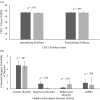Parenting stress, maternal depression and child mental health in a Melbourne cohort before and during the COVID-19 pandemic
- PMID: 36371627
- PMCID: PMC9537807
- DOI: 10.1111/jpc.16155
Parenting stress, maternal depression and child mental health in a Melbourne cohort before and during the COVID-19 pandemic
Abstract
Aim: This paper aims to examine the maternal and child mental health and parenting outcomes in the context of COVID-19 pandemic conditions using a sample from Melbourne, Australia - a city exposed to one of the longest lockdowns world-wide in response to the pandemic.
Methods: This study utilises observational data from a prospective, pregnancy cohort, Mercy Pregnancy Emotional Wellbeing Study and includes 468 women and their children followed up in Melbourne to 3-4 years postpartum pre-COVID pandemic and compared to those followed up during the COVID-19 pandemic.
Results: When compared to mothers followed up at 3-4 years postpartum pre-pandemic, those followed up during the COVID-19 pandemic showed higher depressive symptoms with a steep incline in their symptom trajectory (EMMdifference = 1.72, Bonferroni-corrected P < 0.01, d = 0.35) and had a three times higher risk of scoring 13 or above on the EPDS (aRR = 3.22, Bonferroni-corrected P < 0.01). Although this increase was not associated with the variation in the duration of exposure to pandemic conditions, the steep increase in depressive symptoms was more pronounced in those with pre-existing depressive disorders. There was no difference in parenting stress or adjusted childhood mental health symptoms or disorder.
Conclusions: Our findings highlight the vulnerability of those with pre-existing clinical mental health disorders and the need for adequate clinical care for this vulnerable group. Equally, our study indicates the possibility that parenting and early childhood mental health outcomes, at least in the short term, may be resilient.
Keywords: COVID-19; childhood mental disorders; depression; pandemic; parenting.
© 2022 The Authors. Journal of Paediatrics and Child Health published by John Wiley & Sons Australia, Ltd on behalf of Paediatrics and Child Health Division (The Royal Australasian College of Physicians).
Figures

 ) Before COVID‐19 and (
) Before COVID‐19 and ( ) During COVID‐19.
) During COVID‐19.
 ) Before COVID‐19 and (
) Before COVID‐19 and ( ) During COVID‐19.
) During COVID‐19.Comment in
-
Letters to the Editor.J Paediatr Child Health. 2023 Mar;59(3):597-598. doi: 10.1111/jpc.16348. Epub 2023 Jan 31. J Paediatr Child Health. 2023. PMID: 36718856 No abstract available.
References
-
- Dancause KN, Laplante DP, Oremus C, Fraser S, Brunet A, King S. Disaster‐related prenatal maternal stress influences birth outcomes: Project Ice Storm. Early Hum. Dev. 2011; 87: 813–20. - PubMed
-
- Engel S, Klusmann H, Laufer S et al. Trauma exposure, posttraumatic stress disorder and oxytocin: A meta‐analytic investigation of endogenous concentrations and receptor genotype. Neurosci. Biobehav. Rev. 2019; 107: 560–601. - PubMed
-
- Roseboom T, de Rooij S, Painter R. The Dutch famine and its long‐term consequences for adult health. Early Hum. Dev. 2006; 82: 485–91. - PubMed
Publication types
MeSH terms
Grants and funding
LinkOut - more resources
Full Text Sources
Medical

